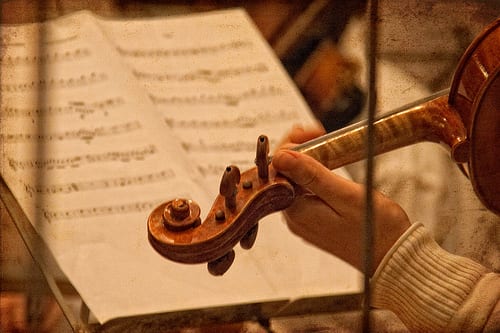 As a beginner violinist, one of the first (and most important) things you should master is how to properly hold your instrument. Learning this will not only help your technique and overall sound, but it will help you avoid unnecessary tension and the injuries that result from it.
As a beginner violinist, one of the first (and most important) things you should master is how to properly hold your instrument. Learning this will not only help your technique and overall sound, but it will help you avoid unnecessary tension and the injuries that result from it.
If you do start feeling tension, you’ll want to take a look at your positioning and correct it right away. Here are a few steps to take to determine the cause:
1. Check your shoulder rest.
A shoulder rest that isn’t adjusted properly can restrict movement and cause your shoulder to press upward. The violin should rest comfortably on your collar bone; in this position, you should be able to raise your bowing arm straight up without any restrictions.
2. Adjust your chin rest.
Similarly, if your chin rest isn’t just right, you may find yourself pressing your head down too hard, resulting in tension in your shoulders, jaw and/or neck. You should be able to rest your chin and then turn your head and nod slightly in order to find a comfortable spot. If you can’t find that sweet spot easily, the chin rest may need to be lowered or raised.
3. Correct your bow alignment.
Depending on your build and the length of your arms, you may find yourself overstretching or feeling cramped in certain positions. This can result in unnatural movements, a shaky or bouncing bow, and of course, tension. First, adjust your shoulder rest and chin rest to comfortable positions, so that your elbow can move freely and your shoulder socket isn’t stretching or cramping. Next, take a good look at your bowing technique. If your bow is staying straight, you may need to adjust the angle of your fingerboard.
4. Sit straight!
This is a given for all musicians. Playing with good posture will make a huge difference, so keep your back straight and your feet planted on the floor. No slouching – lazy practice is just ineffective practice! If you’re standing and find yourself leaning backwards, go back to step #3 – you may just need to reposition your instrument, chin rest or shoulder rest (seeing a pattern here?).
5. Breathe.
Beginner violinists may find themselves holding their breath and creating unnecessary tension while playing, especially if you’re nervous. So above all, don’t forget to breathe! Try counting slowly as you inhale and exhale, especially right before a performance to calm and center yourself.
Looking for violin lessons near you? Search for a violin teacher and learn more about the TakeLessons program today!
Get instrument-specific updates and expert advice, tips and more – right in your inbox! Sign up for email updates here!
You might also like…
– Your Violin vs. Humidity: Summer Violin Care
– What is Rosin, and How Do I Use It?
– 3 Straightforward Steps for Violin Tuning
Photo by hans s.
Suzy S.
